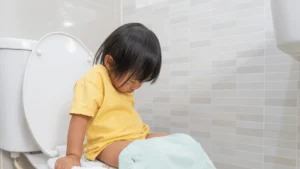Introduction
Constipation is a common problem in children that can cause discomfort and distress. It occurs when the bowel movements become infrequent or difficult to pass. While lifestyle changes, such as increasing fiber intake and physical activity, are the first line of treatment, medication and other therapies may be necessary in more severe cases. This article explores the different types of medications, their examples, safety considerations, home remedies, and other therapies available for treating constipation in children.

Medication Types
There are various types of medications that can be used to help relieve constipation in children. These medications work in different ways to restore regular bowel movements and alleviate discomfort. The most common types include:
1. Bulk-forming agents:
These are natural or synthetic substances that increase the bulk of stool. They absorb water and create a softer, larger mass, making it easier to pass. Examples include psyllium, methylcellulose, and polycarbophil.
2. Osmotic laxatives:
These medications help draw water into the colon, softening the stool and stimulating bowel movements. Examples of osmotic laxatives include polyethylene glycol, lactulose, and magnesium hydroxide.
3. Stimulant laxatives:
Stimulant laxatives work by stimulating the nerves in the intestines, promoting peristalsis and bowel movements. Examples of these medications include senna, bisacodyl, and castor oil.
Safety
It is important to note that medications should only be used under the guidance of a healthcare professional. The dosage and duration of treatment should be determined based on the child’s age, weight, and overall health. Some medications may have potential side effects, such as abdominal cramping or diarrhea, and should be used cautiously. Parents should always discuss any concerns or questions with their child’s healthcare provider.
Home Remedies
In addition to medication, several home remedies can help alleviate constipation in children. These include:
1. Increase fiber intake:
Encourage your child to consume fiber-rich foods, such as fruits, vegetables, whole grains, and legumes. Fiber adds bulk to the stool, promoting regular bowel movements.
2. Increase fluid intake:
Make sure your child drinks plenty of water and other fluids throughout the day. Staying hydrated helps soften the stool and prevent constipation.
3. Encourage physical activity:
Regular exercise aids in digestion and promotes bowel movements. Encourage your child to engage in activities that get them moving, such as biking, swimming, or playing sports.
Other Therapies
Apart from medications and home remedies, there are other therapies that can be beneficial in treating constipation in children. These may include:
1. Biofeedback:
This therapy involves working with a specialist who helps the child learn how to relax and coordinate the muscles involved in bowel movements.
2. Massage:
Gentle abdominal massage can help stimulate the digestive system and relieve constipation.
3. Acupuncture:
Though less commonly used in children, acupuncture has shown some positive effects in improving bowel function and reducing constipation symptoms.
Summary
Constipation in children can be effectively treated with a combination of medications, home remedies, and other therapies. Medication types, such as bulk-forming agents, osmotic laxatives, and stimulant laxatives, can help restore regular bowel movements. However, it is important to prioritize safety and consult with a healthcare professional before starting any medication. Home remedies, such as increasing fiber and fluid intake, along with regular physical activity, can also aid in relieving constipation. In more severe cases or when lifestyle modifications are insufficient, other therapies like biofeedback, massage, or acupuncture can be explored under medical guidance. By following appropriate interventions, parents and healthcare providers can help alleviate constipation and improve the overall well-being of children.